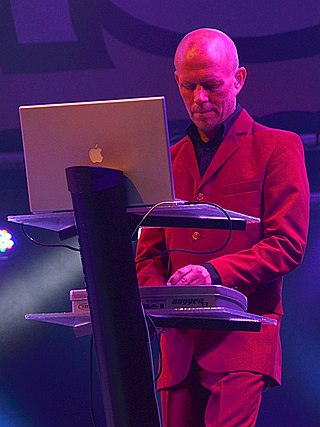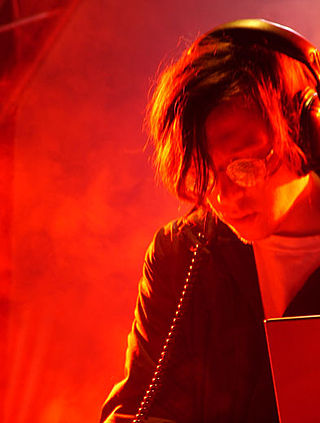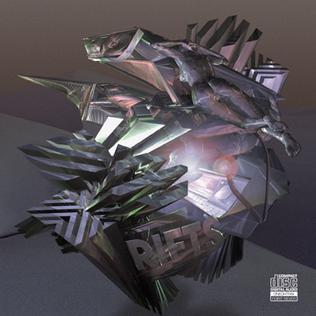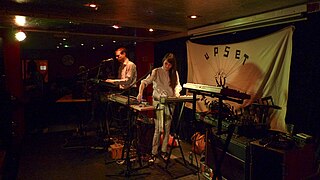Related Research Articles
Electronic music broadly is a group of music genres that employ electronic musical instruments, circuitry-based music technology and software, or general-purpose electronics in its creation. It includes both music made using electronic and electromechanical means. Pure electronic instruments depended entirely on circuitry-based sound generation, for instance using devices such as an electronic oscillator, theremin, or synthesizer. Electromechanical instruments can have mechanical parts such as strings, hammers, and electric elements including magnetic pickups, power amplifiers and loudspeakers. Such electromechanical devices include the telharmonium, Hammond organ, electric piano and electric guitar.

The Roland TB-303 Bass Line is a bass synthesizer released by Roland Corporation in 1981. Designed to simulate bass guitars, it was a commercial failure and was discontinued in 1984. However, cheap second-hand units were adopted by electronic musicians, and its "squelching" or "chirping" sound became a foundation of electronic dance music genres such as acid house, Chicago house and techno. It has inspired numerous clones.

Digital music technology encompasses the use of digital instruments, computers, electronic effects units, software, or digital audio equipment by a performer, composer, sound engineer, DJ, or record producer to produce, perform or record music. The term refers to electronic devices, instruments, computer hardware, and software used in performance, playback, recording, composition, mixing, analysis, and editing of music.
Synth-pop is a music genre that first became prominent in the late 1970s and features the synthesizer as the dominant musical instrument. It was prefigured in the 1960s and early 1970s by the use of synthesizers in progressive rock, electronic, art rock, disco, and particularly the Krautrock of bands like Kraftwerk. It arose as a distinct genre in Japan and the United Kingdom in the post-punk era as part of the new wave movement of the late 1970s.

The Minimoog is an analog synthesizer first manufactured by Moog Music between 1970 and 1981. Designed as a more affordable, portable version of the modular Moog synthesizer, it was the first synthesizer sold in retail stores. It was first popular with progressive rock and jazz musicians and found wide use in disco, pop, rock and electronic music.
Electropop is a popular music fusion genre combining elements of the electronic and pop styles. It has been described as a variant of synth-pop with outstanding heavy emphasis on its electronic sound. The genre was developed in the 1980s and saw a revival of popularity and influence in the late 2000s.

Vincent John Martin, known professionally as Vince Clarke, is an English synth-pop musician and songwriter. Clarke has been the main composer and musician of the band Erasure since its inception in 1985, and was previously the main songwriter for several groups, including Depeche Mode, Yazoo, and the Assembly. In Erasure, he is known for his deadpan and low-key onstage demeanour, often remaining motionless over his keyboard, in sharp contrast to lead vocalist Andy Bell's animated and hyperactive frontman antics.

Legowelt is a Dutch composer, electronic musician and visual artist, whose music spawns a varying range of sub-genres.
Cold wave is a loosely defined music genre that emerged in Europe the late 1970s, characterized by its detached lyrical tone, use of early electronic music instruments and a minimalist approach and style. It emerged from post-punk bands who, influenced by German electronic group Kraftwerk, made use of affordable portable synthesizers such as the Korg MS-20.

A synthesizer is an electronic musical instrument that generates audio signals. Synthesizers typically create sounds by generating waveforms through methods including subtractive synthesis, additive synthesis and frequency modulation synthesis. These sounds may be altered by components such as filters, which cut or boost frequencies; envelopes, which control articulation, or how notes begin and end; and low-frequency oscillators, which modulate parameters such as pitch, volume, or filter characteristics affecting timbre. Synthesizers are typically played with keyboards or controlled by sequencers, software or other instruments and may be synchronized to other equipment via MIDI.
Post-disco is a term to describe an aftermath in popular music history circa 1979–1986, imprecisely beginning with the backlash against disco music in the United States, leading to civil unrest and a riot in Chicago known as the Disco Demolition Night on July 12, 1979, and indistinctly ending with the mainstream appearance of new wave in 1980. During its dying stage, disco displayed an increasingly electronic character that soon served as a stepping stone to new wave, old-school hip hop, Euro disco, and was succeeded by an underground club music called hi-NRG, which was its direct continuation.

The use of electronic music technology in rock music coincided with the practical availability of electronic musical instruments and the genre's emergence as a distinct style. Rock music has been highly dependent on technological developments, particularly the invention and refinement of the synthesizer, the development of the MIDI digital format and computer technology.
Techno is a genre of electronic dance music which is generally produced for use in a continuous DJ set, with tempos being in the range of 120 to 150 beats per minute (BPM). The central rhythm is typically in common time (4/4) and often characterized by a repetitive four on the floor beat. Artists may use electronic instruments such as drum machines, sequencers, and synthesizers, as well as digital audio workstations. Drum machines from the 1980s such as Roland's TR-808 and TR-909 are highly prized, and software emulations of such retro instruments are popular.

Veronica Vasicka is a photographer, record label founder, radio and club DJ. She is the founder of Minimal Wave Records, a record label focused on obscure electronic music from the 1970s and 1980s, as well as its sub label Cititrax, a platform for newer artists.

In Trance 95 is a Greek electronic music band from Athens.
Minimal Wave Records is a New York City-based independent record label founded by Veronica Vasicka in 2005. The label was launched "to create a network for synth wave enthusiasts and promote 80s electronic music via an online archive and vinyl releases. The label specializes in high-quality vinyl pressings of minimal synth and new wave artists."

Rifts is a 2009 compilation album by Oneohtrix Point Never, the solo alias of Brooklyn electronic musician Daniel Lopatin. The album collects Lopatin's early synth-based recordings under the moniker dating back to 2003, including the three limited-run LPs Betrayed in the Octagon (2007), Zones Without People (2009) and Russian Mind (2009), as well as several additional cassette and CD-R releases. It was originally released on No Fun Productions in 2009 as a 2 disc set.
Electronic rock is a music genre that involves a combination of rock music and electronic music, featuring instruments typically found within both genres. It originates from the late 1960s when rock bands began incorporating electronic instrumentation into their music. Electronic rock acts usually fuse elements from other music styles, including punk rock, industrial rock, hip hop, techno and synth-pop, which has helped spur subgenres such as indietronica, dance-punk and electroclash.

Xeno & Oaklander is an American electronic music group formed in 2004, consisting of musicians Sean McBride and Liz Wendelbo. Originating from Brooklyn, the band is considered to be among the cold wave revival scene of the 2000s and 2010s.
References
- 1 2 3 4 Gabriele, Timothy (11 June 2010). "Various Artists: The Minimal Wave Tapes Volume One [review]". PopMatters.com. Retrieved 18 June 2010.
- 1 2 3 4 Vasicka, Veronica (26 January 2010), "20 best: Minimal Wave", FACT magazine, retrieved 18 June 2010
- ↑ Tantum, Bruce (1 December 2009). "A synth-obsessed label turns four". Time Out . Retrieved 28 February 2011.
- ↑ Boffi, Salome (28 August 2022). "Minimal Wave als Genre im Überblick [interview transcript]". rss.com. Retrieved 31 August 2022.